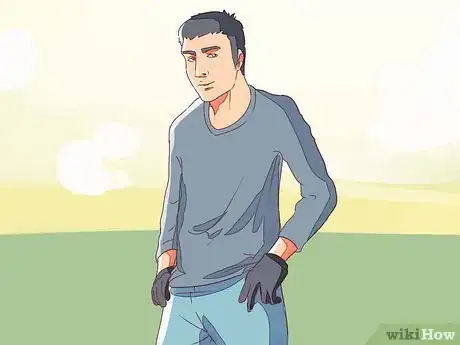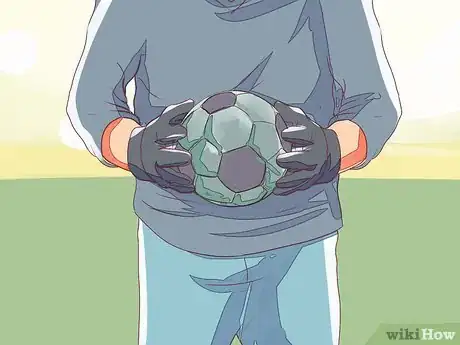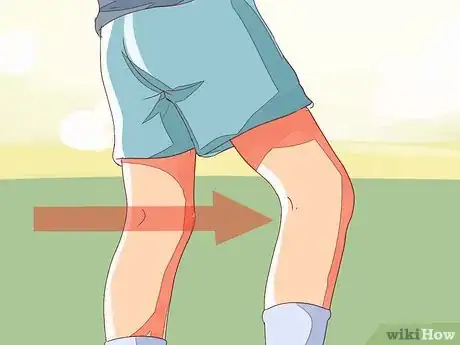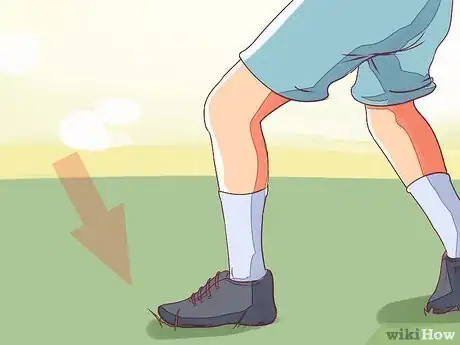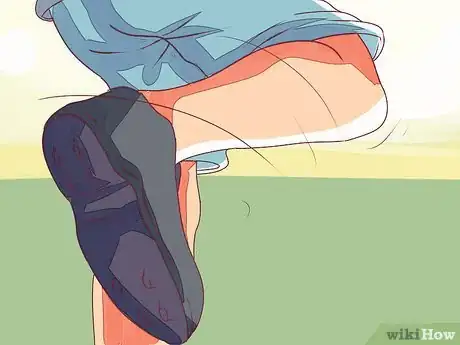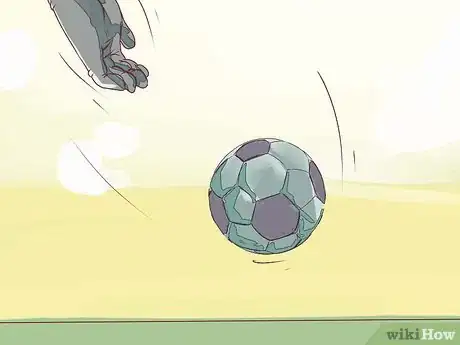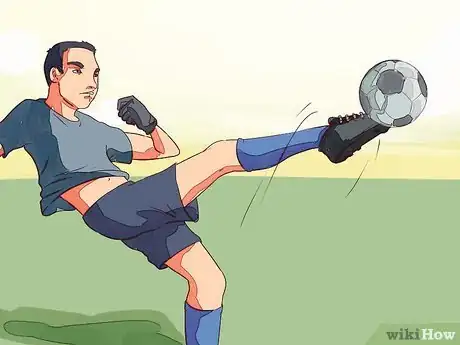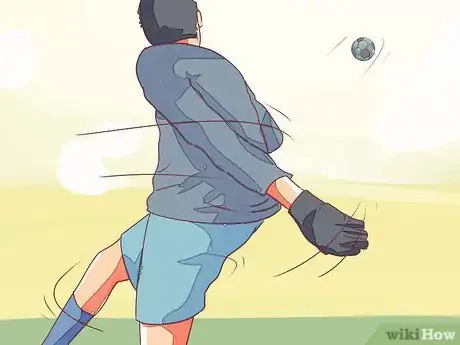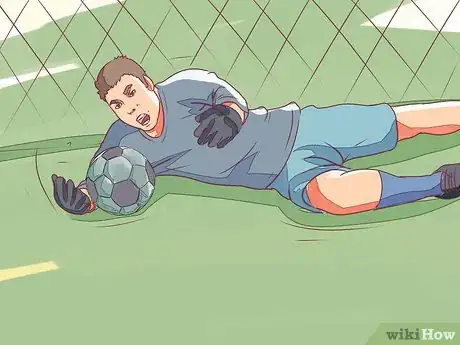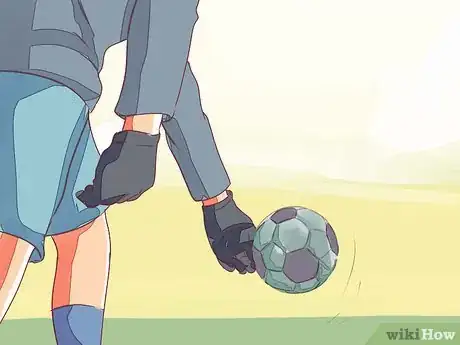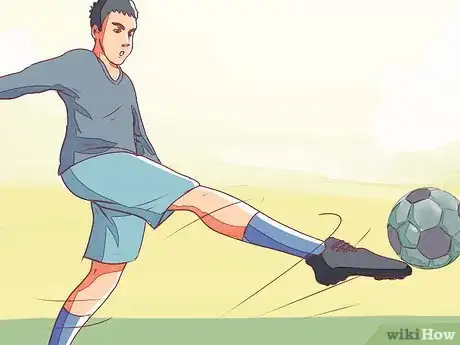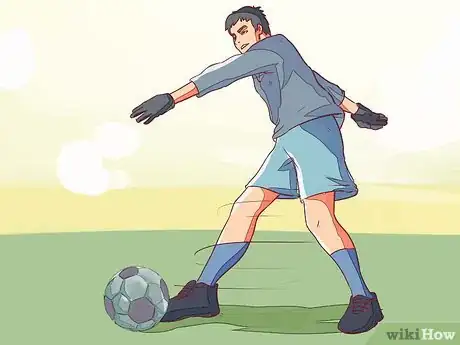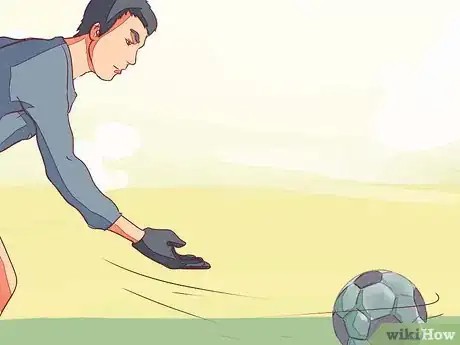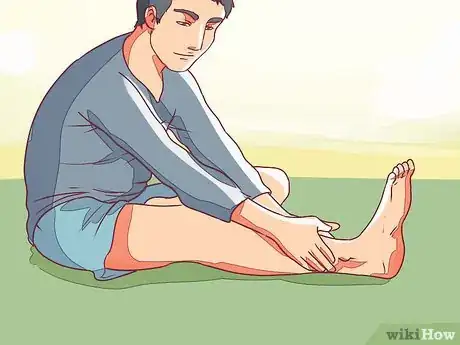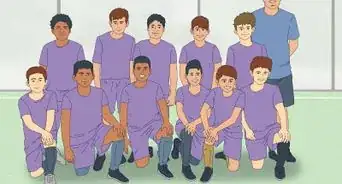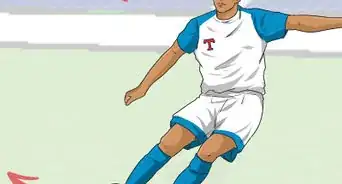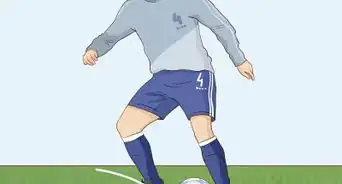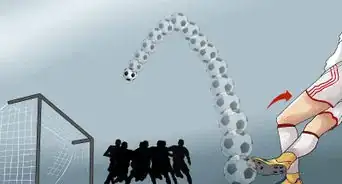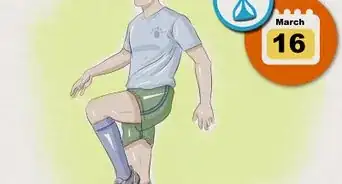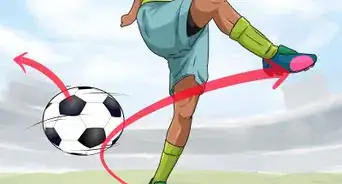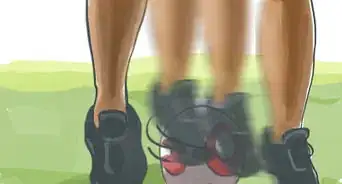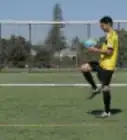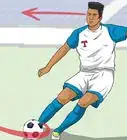wikiHow is a “wiki,” similar to Wikipedia, which means that many of our articles are co-written by multiple authors. To create this article, 24 people, some anonymous, worked to edit and improve it over time.
This article has been viewed 63,016 times.
Learn more...
The punt is the first play of a transition into the offense. If you've just made a spectacular save, you want to give your team the best chance of taking control of the ball and taking it downfield to score. You can learn the mechanics of a basic soccer punt, as well as some tips on how to punt well, to give your soccer team the best chance for success.
Steps
Learning the Basics
-
1Punt only if you’re the goalie. The only player on the soccer field who will ever pick up the ball for a punt is the goalie. There is no circumstance in soccer that allows any other player to punt the ball. While you might be called on occasionally in practice to pick up the ball and punt it, it's not a skill that you need to practice unless you're the goalie.
- Punts must be made within the 18 yard (16.5 m) box. When you pick up the ball, you can punt anywhere inside your box. If you want to take it outside of the box, you've got to drop it on the ground.
-
2Hold the ball at waist height. When you pick up the ball, hold it in both hands gently, at a height about even with your waist. It doesn't need to be perfect, but it's usually easiest to punt the ball by dropping it from waist-height and no higher. Your arms should be out straight from your body, with the ball held in your fingers.[1]
- You'll see many goalies dribbling the ball before they punt it, or holding it in one hand while they gesture, but you should hold onto the ball securely with two hands as you complete your pre-punt steps. Don't try to get fancy. Just hold the ball.
- Punting a soccer ball will happen pretty fast, which means a lot of steps will have to happen at once. Most goalies will have the ball in one hand as they take the steps and extend and drop it in one big fluid motion. Practice blending all these steps together to make it comfortable for you.
Advertisement -
3Take your first step with your kicking foot. Take your lead step with the step you'll eventually kick with. Your dominant foot should be used to punt the ball, which is the foot you'd normally kick with. If you're right-footed, take your first step with your right foot.[2]
- Some goalies will elect to take multiple steps, but all you need is two. One lead step and one plant step is all that’s necessary, before bringing your lead leg up and following through with the punt. Practice some to see what is most comfortable and powerful for you. [3]
-
4Push off your lead foot and plant your other foot firmly into the ground. This will provide your pivot point, a form in which you'll lift your kicking leg and launch the ball into play. Your two lead-up steps should happen quickly, and be spread fairly far apart as if you were about to take off running. This will put more power into your kick. The lead steps should happen at the speed of a jog, regardless of how many steps you choose to take in your lead-up.
- As you plant, your kicking leg should be cocked back behind you, trailing from your initial step. You'll swing it forward to kick with.
-
5Bring your kicking leg straight up. When you plant your pivot foot and leg, imagine your kicking foot is attached by a magnet to the ball. Rotate your hip so your leg comes up perpendicular to the ground, swinging into the ball and making contact. Keep your eyes locked on the ball at all times and stay focused.[4]
- The punt should come from the hip. try to picture your kicking leg as a club that you’re whipping up into the ball as it falls, cranking from your hip joint.
- Rather than coming straight up, many soccer players will cross their leg over their plant leg. A lot of the punt has to do with where you want it to go and what feels most comfortable for you. Practice punting and making the ball go where you want, not on the "perfect" technique.
-
6Drop the ball straight down. The moment just before you start to bring your kicking leg up and swing freely into the ball, remember to drop it straight down in front of you. Just let go. Never toss the ball up to attempt to punt it, or throw it out in front of you. Let your momentum carry you into the ball naturally, don't try to get fancy by throwing it anywhere specifically. The odds of your missing it become much greater if you toss it. Drop it instead.
-
7Point your toe up after contacting the ball. As you're swinging your leg into the kick, point the toes of your kicking foot. The ball should make contact with the hardest part of your foot, just along the laces. As soon as it does, point your foot up, so it makes a right-angle with your shin, as if you were standing normally. This will help to put more lift and distance into your kick.
- Never try to kick the ball with your instep, the tips of your toes, or with any other part of your foot. This will cause the ball to skew off in unpredictable directions.
-
8Follow through. When you’re finished, your foot should come up and point straight in the direction where you want the ball to go, lifting you off the ground gently. You shouldn't have to jump, necessarily, but be careful to let your body follow through with the kick so you don't hyper-extend your hamstring and stretch out your leg uncomfortably. Land gently on your pivot leg, turning your attention immediately back to your goalkeeping duties.[5]
Punting Well
-
1Punt quickly after making the save. Ideally, a punt is an essential transition from defense into offense for your team. If you were quick enough to make a big save, help your team by transitioning quickly and efficiently back into offense, putting the ball into play for your team. Look for open players and open spaces where your players will be able to run onto the ball.
- You want to be quick, but not too quick. Wait until the opposing players clear out of the box and give you enough room to make your punt. Everyone should be heading back downfield to get on defense, and your players should be streaking downfield to get open on offense.
-
2Put the ball into open space. You don't just want to punt randomly, or send the ball back immediately to the other team. Look for open spaces that your teammates will be able to run onto the ball. The momentum should be carrying the ball in the appropriate direction, allowing you to have the advantage, as long as an opponent doesn't get a head or a foot on it. Look for open space and send the ball toward it.
-
3Don’t kick it too high. Think of a punt as the first play of an offensive movement. Don't just send the ball straight up into the air because it's fun. try to make something happen with it. Eventually, you want the ball to be going toward your opponent's goal, not straight up in the air. It's harder for your teammates to control a very high-arcing punt, so focus on keeping your punts long and accurate, not super-high and out of control.
- If your punts tend to go extremely high, focus on letting the ball drop down a little farther before you make contact with it. Most goalies drop the ball almost all the way to the ground before making contact. Start dropping the ball slightly earlier in your punt to get the timing correct.
-
4Practice your back-spin. One excellent way of controlling wild punts is in working on your back-spin, making the ball arc and head downfield, but stop rolling upon landing, giving your punt a more reliable accuracy. This is done by bringing your toe up as soon as you make contact with the ball, creating a right angle with your foot and your shin. If you can punt like this, it'll be a lot easier for your teammates to control the punt eventually.
-
5Don’t punt every time. Instead of punting, you can also roll the ball to one of your teammates after the opposition has cleared out, or you can throw the ball to your teammates as they’re transitioning into offense. This can sometimes be a much-quicker, though less powerful, way of getting the ball into play. If your opponents defenders are pushed way up toward the midfield, punting might turn the ball right back over to them. It might be smarter to roll the ball to one of your defenders and transition into offense that way.[6]
- It's also common for some goalies to toss the ball onto the ground and take an impromptu free-kick. You'll definitely want to make sure that all of your opponents have cleared out completely if you try this, because they'll be able to come in for a challenge as soon as you put the ball on the ground.
-
6Stretch out your hamstring first. Because you’ll be stretching your kicking leg somewhat high to complete a punt, it’s important to stretch out thoroughly before attempting or practicing punts, and never attempt to punt “cold.” Always follow through with your kicks to keep your hamstrings safe and loose.
Community Q&A
-
QuestionSometimes I have a floppy foot and do a bad kick. How can I prevent this?
 Community AnswerTry to use the inside of your foot, where the curve is. Before you kick the ball, plant your other foot (the one you are not using to kick with) in the direction you want the ball to go.
Community AnswerTry to use the inside of your foot, where the curve is. Before you kick the ball, plant your other foot (the one you are not using to kick with) in the direction you want the ball to go. -
QuestionHow do I stretch my hamstring?
 Community AnswerI do lunges. I also walk three steps, stop, and try to touch my toes. Finally I also do high knees/high knee karaoke and butt-kicks to stretch my hamstrings.
Community AnswerI do lunges. I also walk three steps, stop, and try to touch my toes. Finally I also do high knees/high knee karaoke and butt-kicks to stretch my hamstrings.
Warnings
- If you accidentally hit the ball the wrong way, it may go very low or not very far, and then the opponents will block it and get an automatic shot on goal.⧼thumbs_response⧽
- If you are not careful about where you point your foot, the ball may accidentally come right behind you into your own goal!⧼thumbs_response⧽
References
- ↑ https://athleticlift.com/how-to-punt-soccer-ball/
- ↑ http://dearsportsfan.com/2014/09/24/how-do-punts-work-in-football/
- ↑ https://protips.dickssportinggoods.com/sports-and-activities/football/special-teams-tips-punting-101
- ↑ https://www.youtube.com/watch?v=HANyK23Hquc
- ↑ https://www.stack.com/a/how-to-punt-a-football-a-step-by-step-photo-guide
- ↑ https://athleticlift.com/how-to-punt-soccer-ball/
About This Article
To punt a soccer ball, start by holding the ball in your hands at waist height. Then, take a step with your kicking foot and push off of it before planting your other foot on the ground. Next, when you're ready, drop the ball straight down toward the ground. At the same time, bring your kicking leg straight up so it makes contact with the ball. Right after you make contact with the ball, point your toes up so they make a right angle with your shin, which will help the ball go higher and further. To learn how to get better at punting a soccer ball, scroll down!
